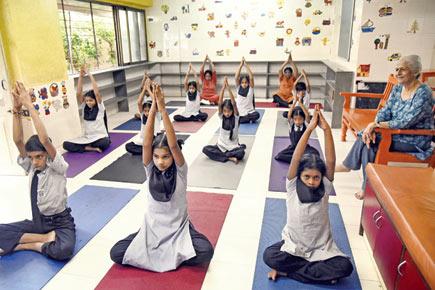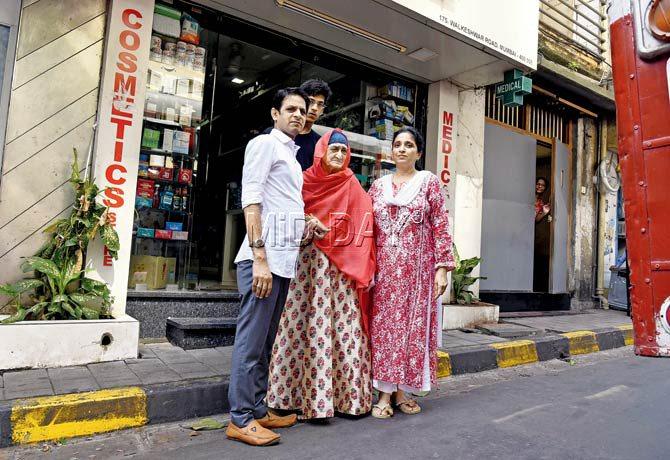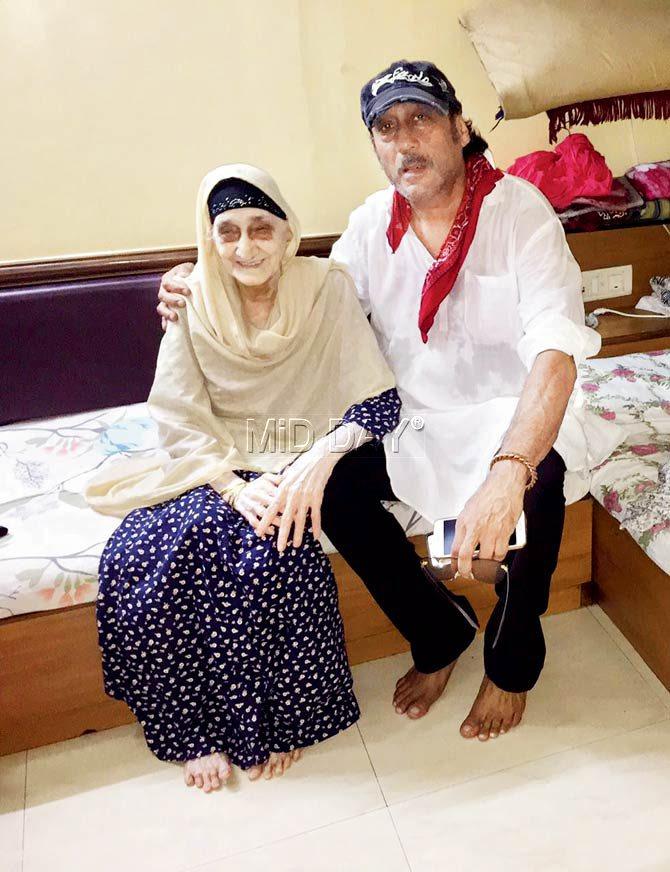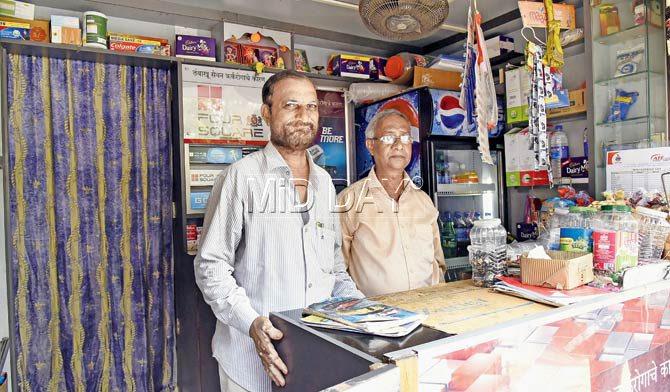Teen Batti in Walkeshwar has gone from dhobi ghat to aristocratic bungalows to random redevelopment


A morning yoga session at Bal Anand, the play-and-learn school founded by Devi Mangaldas’ (sitting extreme right) mother over 60 years ago, influenced by J Krishnamurti's philosophy. Pic/Shadab Khan
I love what I'm listening to. Ambling around Walkeshwar's Teen Batti junction brings to the ear snatches of my mother tongue aired in ways more varied than imaginable.
ADVERTISEMENT
Reeling off phrases cadenced to each community's taste, Parsis, Banias, Jains, Bohris and some Sunnis speak the reigning language here. Even staunch Shindes from Ratnagiri break into this lingo picked up from locals at their provisions shop with a fluidity which would stun my Navsari ancestors.
Catering to customers since the 1930s, Rukminibai Baburao Shinde, grandmother of Chandrakant and Vijay, rolled beedis with a team of women at the spot where Shinde Brothers stands. "Each of them rolled tight 300 to 500 beedi bundles. Later, our father Kishanrao began stocking bread, butter and cold drinks," Vijay says.
Though the three streetlights (Teen Batti) crown an ordinary lamppost, this was once an ornate cluster of gaslights, leading to Malabar Hill's crest. I stick to exploring the Dongersi Road and Walkeshwar Road slope till Sterling Bay, Pallonji Mistry's mansion.

Vikram Jain and his son Raj outside their pharmacy with their long-time neighbours in Navyug Chawl — 95-year-old Fatima Abdulrehman Vora and her daughter Nazma, who is Jackie Shroff's rakhi sister
Vijay Shinde rewinds to accounts narrated by his father — from Jinnah visiting barrister Somji at Dani Sadan across the street, to eminent jurists personally popping into their shop for Milan supari, to the flyaway exit of Penny, Shapoor Mistry's pet African Grey, possibly lost to thickets in adjoining Raj Bhavan. The gubernatorial seat since 1885 has its own pin code — 400035 — the rest of the road 400006.
"Builders have swallowed our area's regal residences," says Pradeep Pandya from his porch swing. His aunt and uncle, Drs Sharda and Raman Upadhyaya, counted among their patients actors Tanuja and Nutan, driving to the dispensary in an Impala. It was Stardust Street. Before Jackie Shroff made famous his room at Navyug Chawl, an absolute who's who of filmdom and politics have had a Walkeshwar Road address. Many of them in 1942-built Rockside, including Vice President and Chief Justice Mohammad Hidayatullah, Justice SN Variava, thespian Motilal considered the country's first "natural actor" and India's oldest living first-class cricketer, Vasant Raiji, happy to chat about his adored game at a spirited 97.

The actor, who grew up next door to the Voras, recently visited them on Eid day. Pic courtesy/Nazma Vora
In Rockside from age five to 80 now, Thrity Stafford recalls jackals howling in jungles around Governor's House, panoramic Arabian Sea views from bay windows, Surendra Nath's soulful harmonium strains wafting to her two floors up, maalis of neighbouring gardens dancing the lezim towards sunset, owls nesting in the cliffs behind.
"Soldiers in tin shed barracks on Ridge Road above, relaxed dangling their legs over the rock edge," says Stafford. "We flashed V for Victory signs and sang war songs together."
Between Pandya's home and the Shindes' shop, Tip Top Cleaners was initially the grain stall of Bhimshi Murji from Kodai village in Kutch. Behind his grandson, Viral, who runs the laundry, looms a wood planked loft — the "maarya" — a typical mezzanine level resting place shops were designed with.
The police chowky on the bend where Ridge Road turns leftward to Walkeshwar Road was a wireless receiving station for all Maharashtra. Playback singer Priti Sagar still stays in pretty Anil Nivas near Anjuman Islam Mosque in Bhatia Building. A miniature marvel sandwiched between Dani Sadan and Sterling Bay is Bombay's tiniest fire temple, 158-year-old Thoothi Agiary, with a well believed to have wish-granting powers.

Vijay and Chandrakant Shinde at their provisions store Shinde Brothers on Walkeshwar Road. Almost a century ago, their grandmother Rukminibai worked with an all-women team at the spot, rolling beedi bundles
The most dramatic disappearance has to be a dhobi ghat behind the Agiary, south Bombay's second largest such ghat, with hundreds of washermen working and living in 52-room Cooverbai Chawl. "Kya hulchul tha, bilkul mela jaise — this place was busy, like a fair," says ironing man Nandlal Pardesi. His grandfather Girdharilal walked the miles from Lucknow as a 20-year-old around 1930. Red mud roads clop-clopped by ghoda-gaadi meant plenty of soiled clothes to be slapped clean.
A few feet on, 100-year-old atta grinding chakkis like Bharat Flour Mill keep puffing clouds too thick to see any more than a silhouette of the powder-sheathed miller. Vijay Watch Co. and vegetable vendors weighing greens with ancient brass measures keep ancestral trades alive. Shrill peacocks, mongooses and monkeys snatching bananas from fruit sellers are occasional sights, unlike their one-time profusion in lawns and knolls chirpy with parrots and paradise flycatchers.
I reach Daskot remembering a 1980s interview with vintage car king Pranlal Bhogilal at his sandstone residence. Beyond gates in walls embellished with the crest of a lion and prancing horse, I was ushered into a maze of Ming vases, Chola bronzes and Czar Nicholas II's candelabra. As I sipped juice from the heaviest silver glass on earth, the tycoon trilled in trademark high pitch to someone on the phone about Richard Attenborough featuring his 1934 Buick in Gandhi. "Maare toh kehvu padyu, I had to inform Sir Richard not to show Gandhiji in a Bentley or Rolls. Those were not for national leaders."
Freedom patriots to movie moguls have long patronised Jain Medical Centre in Navyug Chawl. Vikram Jain drops Parsi upper crusty mention of Pallonji Sahib, the Godrejs, Vakils and Camas. "Class jato rayo, old money is outnumbered by the nouveau riche." His great-great-grandfather from Falna in Rajasthan came to 1850s Bombay. "My dadaji, Otermal, ran a general store at this gala in the 1950s, which became our pharmacy."
Vikram introduces me to the Voras next door. At 95, frail Fatima Abdulrehman Vora is wonderfully lucid — "This was fully forested in 1936 when I came married from Tarapore. My in-laws' opened a tabela, which became our milk shop." Her daughter, mehndi artist Nazma, is "Jaggu" Shroff's rakhi sister, inseparable from childhood in Navyug.
Between 1970 and '80, Jain and Marwari merchants poured in. "There's a major change in the social fabric," says Shaan Khatau. We are walking in her compound of 27-storey Lands End, among the city's earliest skyscrapers in 1967-'68.
The owners of Asia's oldest newspaper have also had redeveloped their ancestral bungalow where Manmohan Desai shot scenes of Amar Akbar Anthony. Over tea and batasa biscuits in her present home, the family matriarch reminisces: "We married in our garden, under chickoo, guava and coconut trees with parrots and magpies chattering above. The Brits were nice to talk to but not keen on socializing, unsure which Indians around them ate meat. It was amusing to pass their cottage hallways where they sat for supper formally dressed, down to bow-ties, just husband and wife too!"
Flaking, fading, yet fortunately spared, a sprinkling of structures offer moldy glimpses of grandeur. On the top floor of Beaulieu, now in crumbling neglect, lived Governor Mangaldas Pakvasa. His granddaughter, danseuse Sonal Mansingh, married in the next door Cosy Corner bungalow garden. Her sister Arti Mehta tells me Beaulieu's beautiful circular staircase wound up to their apartment. Their mother Poornima participated in the Dandi March and was jailed with Kasturba Gandhi at 17. An octogenarian spending six decades in the building, says, "Beaulieu's lovely high ceilings reminded us of a palace."
Heartening to admire better preserved, close to a century Himmat Nivas. A statue of Athena adorning its gable, this was Pupul Jayakar's Bombay home. Her daughter Radhika Herzberger, Rishi Valley School director, shares J Krishnamurti would stay with them in the city. Another legendary resident, Madam Korosch's bead bags and sequin-embroidered sarees were the talk of the town. Her master darzis crafted Nargis' black saree for the 1951 hit Awara. The German Jew seamstress enjoyed dhansak meals with Parsi clients.
Bade Ghulam Ali Khan occupied Himmat Nivas' top floor, from where his mellifluous riyaaz rippled wide. On dominantly vegetarian turf, the Ustad's preference for kababs features in Sheila Dhar's Raga'n Josh: Stories from a Musical Life – "Bade Ghulam Ali Khan announced to a host he could hardly produce his music given grass to eat. 'Ai khana, te ai gana?' he exclaimed shocked."
My favourite stop is Bal Anand. Three generations have play-learnt at this joyful niche counsellor Devi Mangaldas' mother Nandini Mehta (Jayakar's sister) founded in 1954. Noticing Matu and Bhaja, children from shoreline jhopdis, huddled in her 25 Dongersi Road entrance, she invited them in and handed them crayons. "Two to 10 to 75, this school sprang not from theories of education but an act of compassion," says Mangaldas.
Students under mango trees sculpted with Piloo Pochkhanawala, shaped pottery with Primula Pandit, painted with expressive abandon — "Mother urged them to draw their inner world." Moved to a pair of garages in Akash Deep building, Bal Anand's confined space reaffirms the energy it always radiated. The home cooked snack, a 60-year practice, continues being lovingly served. Small is indeed beautiful here.
Author-publisher Meher Marfatia writes fortnightly on everything that makes her love Mumbai and adore Bombay. You can reach her at mehermarfatia@gmail.com
 Subscribe today by clicking the link and stay updated with the latest news!" Click here!
Subscribe today by clicking the link and stay updated with the latest news!" Click here!







